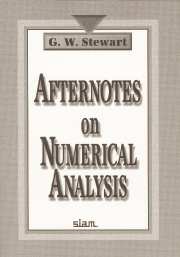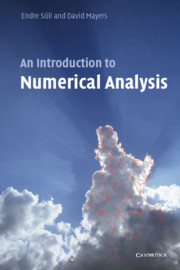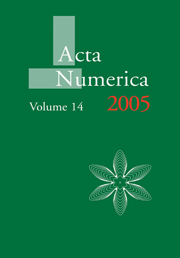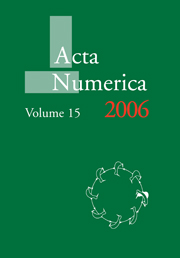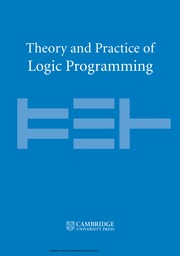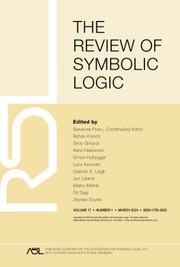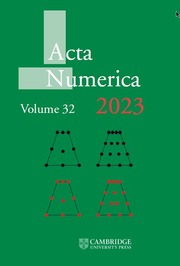Afternotes on Numerical Analysis
There are many textbooks to choose from when teaching an introductory numerical analysis course, but there is only one Afternotes on Numerical Analysis. This book presents the central ideas of modern numerical analysis in a vivid and straightforward fashion with a minimum of fuss and formality. Stewart designed this volume while teaching an upper-division course in introductory numerical analysis. To clarify what he was teaching, he wrote down each lecture immediately after it was given. The result reflects the wit, insight, and verbal craftmanship which are hallmarks of the author. Simple examples are used to introduce each topic, then the author quickly moves on to the discussion of important methods and techniques. With its rich mixture of graphs and code segments, the book provides insights and advice that help the reader avoid the many pitfalls in numerical computation that can easily trap an unwary beginner.
Product details
January 1987Paperback
9780898713626
210 pages
255 × 179 × 12 mm
0.389kg
This item is not supplied by Cambridge University Press in your region. Please contact Soc for Industrial & Applied Mathematics for availability.
Table of Contents
- Part I. Nonlinear Equations: Lecture 1. By the Dawn's Early Light
- Interval Bisection
- Relative Error
- Lecture 2. Newton's Method
- Reciprocals and Square Roots
- Local Convergence Analysis
- Slow Death
- Lecture 3. A Quasi-Newton Method
- Rates of Convergence
- Iterating for a Fixed Point
- Multiple Zeros
- Ending with a Proposition
- Lecture 4. The Secant Method
- Convergence
- Rate of Convergence
- Multipoint Methods
- Muller's Method
- The Linear-Fractional Method
- Lecture 5. A Hybrid Method
- Errors, Accuracy, and Condition Numbers. Part II. Computer Arithmetic: Lecture 6. Floating-Point Numbers
- Overflow and Underflow
- Rounding Error
- Floating-point Arithmetic
- Lecture 7. Computing Sums
- Backward Error Analysis
- Perturbation Analysis
- Cheap and Chippy Chopping
- Lecture 8. Cancellation
- The Quadratic Equation
- That Fatal Bit of Rounding Error
- Envoi. Part III. Linear Equations: Lecture 9. Matrices, Vectors, and Scalars
- Operations with Matrices
- Rank-One Matrices
- Partitioned Matrices
- Lecture 10. Theory of Linear Systems
- Computational Generalities
- Triangular Systems
- Operation Counts
- Lecture 11. Memory Considerations
- Row Oriented Algorithms
- A Column Oriented Algorithm
- General Observations on Row and Column Orientation
- Basic Linear Algebra Subprograms
- Lecture 12. Positive Definite Matrices
- The Cholesky Decomposition
- Economics
- Lecture 13. Inner-Product Form of the Cholesky Algorithm
- Gaussian Elimination
- Lecture
- 14. Pivoting
- BLAS
- Upper Hessenberg and Tridiagonal Systems
- Lecture 15. Vector Norms
- Matrix Norms
- Relative Error
- Sensitivity of Linear Systems
- Lecture 16. The Condition of Linear Systems
- Artificial Ill Conditioning
- Rounding Error and Gaussian Elimination
- Comments on the Analysis
- Lecture 17. The Wonderful Residual: A Project
- Introduction
- More on Norms
- The Wonderful Residual
- Matrices with Known Condition
- Invert and Multiply
- Cramer's Rule
- Submission
- Part IV. Polynomial Interpolation: Lecture 18. Quadratic Interpolation
- Shifting
- Polynomial Interpolation
- Lagrange Polynomials and Existence
- Uniqueness
- Lecture 19. Synthetic Division
- The Newton Form of the Interpolant
- Evaluation
- Existence
- Divided Differences
- Lecture 20. Error in Interpolation
- Error Bounds
- Convergence
- Chebyshev Points. Part V. Numerical Integration and Differentiation: Lecture 21. Numerical Integration
- Change of Intervals
- The Trapezoidal Rule
- The Composite Trapezoidal Rule
- Newton-Cotes Formulas
- Undetermined Coefficients and Simpson's Rule
- Lecture 22. The Composite Simpson's Rule
- Errors in Simpson's Rule
- Weighting Functions
- Gaussian Quadrature
- Lecture 23. The Setting
- Orthogonal Polynomials
- Existence
- Zeros of Orthogonal Polynomials
- Gaussian Quadrature
- Error and Convergence
- Examples
- Lecture 24. Numerical Differentiation and Integration
- Formulas From Power Series
- Limitations
- Bibliography.

